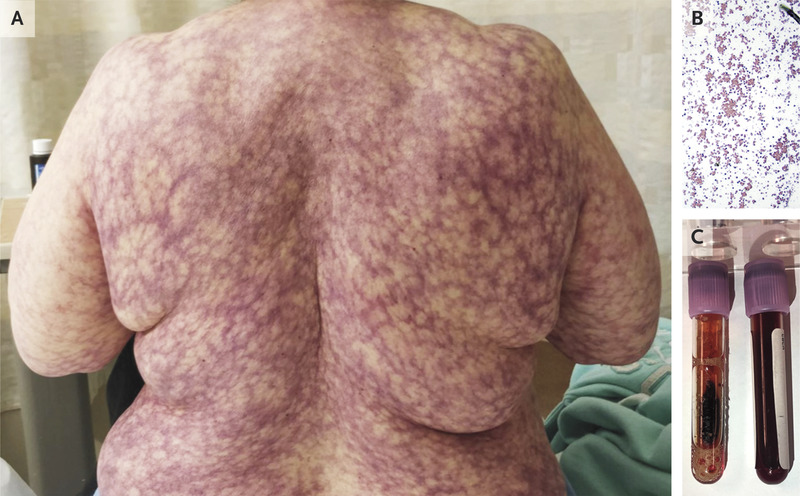Antiphospholipid Syndrome
Autoimmune disease characterised persistent antibodies to circulating anti-phospholipid, causing a pro-coagulant state that may present as:
- Thrombotic APS
Venous, arterial, or microvascular thrombosis.- VTE
- Catastrophic APS
Multi-organ (⩾3) thrombosis within 7 days, often with:- ARDS
- Diffuse alveolar haemorrhage
- Encephalopathy
- Adrenal haemorrhage
- AKI
- Obstetric APS
- Foetal loss after 10th week of gestation
- Recurrent early miscarriages
- IUGR
- Pre-eclampsia with severe features
- Non-thrombotic APS
- Valvular heart disease
- Nephropathy
- Haemolytic anaemia with thrombocytopaenia
- Cognitive dysfunction
CAPS can be clinically indistinguishable from other thrombotic microangiopathies (covered under Thrombotic Microangiopathies); persistent antiphospholipid antibodies are required to confirm the diagnosis.
Epidemiology and Risk Factors
Associations:
- Systemic autoimmune disease
- SLE
Pathophysiology
- β2-glycoprotein I is a circulating plasma protein that binds to phospholipid surfaces
- Antiphospholipid antibody binds to β2-glycoprotein on endothelial cells
These include:- Anticardiolipin antibody
- Lupus anticoagulant
- Anti-β2-glycoprotein antibody
- The antibody-glycoprotein complex induces a procoagulant state by:
- Up-regulating prothrombotic cellular adhesion molecules
- E-selectin
- Tissue factor
- Suppressing tissue factor pathway inhibitor
- Up-regulating prothrombotic cellular adhesion molecules
Aetiology
Clinical Features
Thromboses:
- Venous thrombosis
- DVT
- PE
- Cerebral venous sinus
- Arterial thrombosis
- MI
- Thrombotic valvular disease
- Stroke
- Mesenteric ischaemia
- Skin necrosis
- Miscarriage
Assessment
History:
- Autoimmune disease history
Exam:
- Livedo

Investigations
Bedside:
- TTE
- Valvular vegetations
Laboratory:
- Blood
- FBE
- Thrombocytopaenia
<20×109/L is rare. - Haemolytic anaemia
May be immune-mediated or non-immune mediated.
- Thrombocytopaenia
- Blood film
- Schistocytes
To distinguish haemolytic anaemia type.
- Schistocytes
- Coag
- Isolated ↑ APTT that does not correct on mixing studies
- UEC
- AKI
- Antiphospholipid antibody
- FBE
Imaging:
Other:
Diagnostic Approach and DDx
The Sapporo criteria requires both:
These criteria are incomplete for the full spectrum of APS features, and will probably be revised.
- Thrombotic complication
Including obstetric. - Persistent antiphospholipid antibodies
Management
- Anticoagulation
Heparin with anti-Xa targeting. - Immunosuppression
Resuscitation:
Specific therapy:
- Pharmacological
- For CAPS:
- Anticoagulation
- Heparin preferable
Monitor with anti-Xa targeting 0.3-0.7.
- Heparin preferable
- Immunotherapy
- Corticosteroids
Methylprednisolone 1g daily for 3 days. - IVIG
- Theoretical benefit
- 0.4g/kg for 5 days
- Consider cyclophosphamide or rituximab
- Corticosteroids
- Anticoagulation
- For CAPS:
- Procedural
- For CAPS:
- Plasma exchange
FFP preferred exchange solution.
- Plasma exchange
- For CAPS:
- Physical
anti-Xa detects amount of residual unbound Xa, indicating the degree to which the heparin-antithrombin complex has bound Xa.
Supportive care:
Disposition:
Preventative:
- Secondary prevention
- Aspirin and prophylactic enoxaparin
- Preferred in pregnancy
- Therapeutic anticoagulation
- For VTE or arterial thrombosis
- Warfarin recommended
- Target INR 2-3
- INR target may ↑ to 3-4 if recurrent thromboses
- Evidence supporting DOAC is unclear
- Aspirin may be added if:
- Concurrent coronary artery disease
- Thrombosis occurs on warfarin
- Aspirin and prophylactic enoxaparin
Marginal and Ineffective Therapies
Anaesthetic Considerations
Complications
Prognosis
CAPS:
- 35-50% mortality